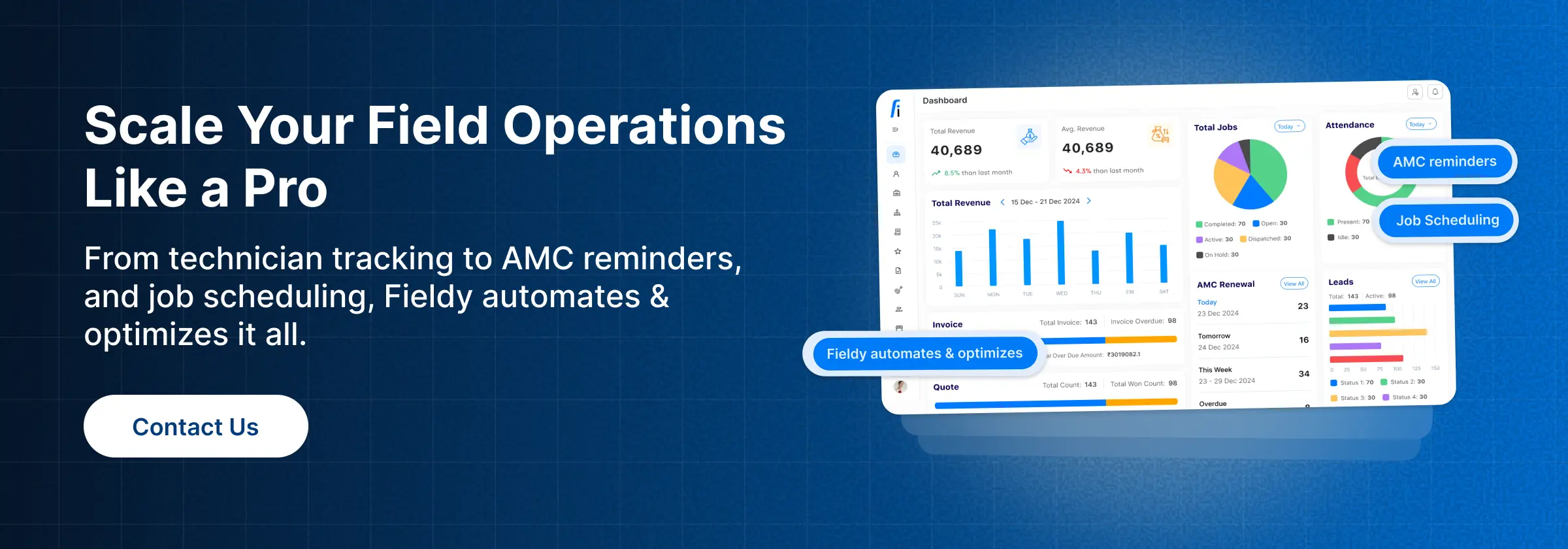🌟 Introduction
🚦 Why Staying “On Track” with Asset Management is Critical in FSM
Assets in field service management (FSM) are the backbone of the operations. What maybe an HVAC system, elevator, pest control sprayer, or a surveillance camera-times represent reliability, revenue, and customer trust. Once this equipment fails, the effect is instantaneous, with downtime increasing, customer confidence waning, and operating costs skyrocketing.
Thus, the term on-track asset management pops up here. Literally, it ensures that assets are monitored, maintained, and serviced at the right time-this is done without undue delays or blind spots. Preventing service interruptions and course-extending are the paramount occasions that keep assets “on track.”
📊 Insights: With modern-day asset tracking, any field service business should no longer rely on manual registers or spreadsheets. Asset visibility can boost workforce productivity by 28%, cut repair and maintenance efforts by 17%, and reduce operational downtime by up to 20%, enabling smoother and more efficient operations. An automated inventory management system ensures assets are easier to locate and manage, saving both time and operational costs.
Thereby, bridging this gap, modern-day solutions like Fieldy provide businesses with dedicated asset management equipment software that automatize monitoring, contract management, and technician updates-Essentially so that the service teams maintain alignment with customer commitments. In addition, many businesses then view larger frameworks such as asset service management and asset management solution areas to see how end-to-end visibility aids efficiency checking.
🧭 What is On Track Asset Management in Field Service?
Asset management on tracks goes far beyond simply knowing the location of a piece of equipment. It is a proactive, structured approach to asset monitoring-on-condition maintenance, preventive servicing, compliance checks, and even eventual replacement planning. Rather than waiting for a failure to affect production, the company ought to foresee possible failures and work toward preventing downtime.
Forward-looking management of assets supports asset instances being tracked right through procurement, through usage, through servicing, warranty coverage, and finally decommissioning.
🏭 Industry Applications of On-Track Asset Management
❄️ HVAC Services
Routine tracking of compressors, filters, and HVAC components helps prevent inefficiencies. Studies indicate that dirty HVAC filters can raise energy consumption by nearly 15%, highlighting the importance of timely servicing.
🏗️ Elevator Companies
Elevators must follow strict inspection schedules due to regulatory requirements. With on-track asset management, missed inspections are avoided, ensuring compliance and preventing costly penalties.
🐞 Pest Control Providers
From chemical tanks to spraying equipment, visibility into condition and usage is critical. Proper monitoring helps maintain safety and compliance standards.
🔒 Security System Firms
Cameras, alarms, and motion sensors demand regular checks and firmware updates. Asset tracking ensures equipment remains reliable, maintaining customer trust and performance guarantees.
📈 Insight: Organizations that rely on proactive scheduling see up to a 30% decrease in unplanned downtime, proving how preventative planning strengthens operational resilience. When combined with field service asset management software, companies unify technicians, equipment data, and maintenance logs into one streamlined system.
⚙️ Core Components of On-Track Asset Management
🗂️ 1. Asset Database & Equipment Register
A centralized register acts as the single source of truth, consolidating data like installation dates, warranty periods, service records, and parts history. For FSM, this asset management equipment database forms the backbone of transparency and efficiency.
🗓️ 2. Preventive Maintenance Scheduling
Preventive maintenance plays a direct role in reducing costs. McKinsey highlights that predictive and preventive strategies can cut downtime by 30-50% and extend machine lifespan by 20-40%. FSM teams with automated scheduling avoid service delays and dissatisfied customers. 🔽🔽🔽
🧾 3. Contract & Warranty Tracking
Manual management of AMCs (Annual Maintenance Contracts) often leads to missed renewals. With digital tools, companies can automate renewals, track warranties, and link contracts to customer records, securing revenue and boosting client retention.
📡 4. Condition Monitoring Tools
IoT sensors allow early detection of equipment issues. For example, vibration sensors in elevators can alert technicians before breakdowns occur, minimizing unexpected downtime.
📱 5. Technician Mobile Access
Mobile-first platforms provide field teams with real-time access to asset conditions, service logs, and checklists. Updates sync instantly with the backend, avoiding miscommunication. Research shows that technicians complete 25% more service calls weekly when they have quick access to asset data and location history.
💼 Benefits of Equipping FSM Teams with Asset Management Equipment
Arming service teams with the right asset management equipment drives measurable gains:
-
⏳ Extended Asset Lifespan: Preventive maintenance can cut capital expenditure by 10% by maximizing equipment life (Deloitte).
-
🧰 Lower Maintenance Costs: Proactive servicing is up to three times cheaper than reactive repairs.
-
👷 Smarter Workforce Allocation: Dispatchers match technician skills with asset needs, increasing job efficiency.
-
🌐 Real-Time Visibility: Cloud-based platforms replace manual paperwork, reducing service record errors.
-
🧾 Compliance & Trust: Detailed logs assure customers of quality while supporting audit and regulatory requirements.
When integrated with strategies to improve workforce productivity in field service, these equipment solutions strike the right balance between cost savings and customer satisfaction.
🚀 How Fieldy Keeps Asset Management On Track
Fieldy unifies the pillars of on-track asset management in one intuitive, easy-to-use platform:
- 🧮 Centralized Asset Dashboard – All contracts, service logs, and maintenance cycles are stored in a single system, giving managers and technicians full visibility into asset histories and operational performance at any time.
- 🔁 Smart AMC Management – Automated reminders for contract renewals and preventive maintenance schedules ensure no deadlines are missed, helping businesses secure ongoing revenue and maintain strong customer relationships.
- 🧩 Role-Based Access & Digital Checklists – Field teams can follow structured, no-code checklists to maintain service consistency, reduce errors, and standardize operational workflows across multiple locations.
- 📍 Live Technician Tracking – By pairing real-time asset data with GPS tracking, managers can dispatch the right technician faster, monitor progress in the field, and provide customers with accurate updates instantly.
- 🔗 Seamless Integrations – Fieldy connects with CRM, invoicing, and scheduling software, keeping asset servicing, billing, and customer communications fully synchronized for smooth operations.
🏢 Industries Benefiting from On-Track Asset Management
- ❄️ HVAC Providers – Pairing HVAC field service software with asset tracking cuts energy waste and streamlines maintenance.
- 🏗️ Elevator Firms – An integrated elevator management system ensures regulatory compliance and prevent liability risks.
- 🔒 Security System Businesses – Security software for field service simplifies large-scale deployments and inspection scheduling
- 🐞 Pest Control Companies – With pest control management software, businesses track inventory, equipment, and safety compliance.
🔔 Conclusion
🔮 The Future of On Track Asset Management in FSM
The future of on-track asset management lies in advanced technologies. IoT sensors, AI-driven predictive analytics, and digital twins are redefining how organizations approach asset care. Gartner predicts that by 2026, 75% of field service companies will use AI or ML for predictive maintenance.
As FSM tools evolve into mobile-first solutions, the role of asset management equipment integrated with CRM, invoicing, and scheduling will become even more central. Companies that invest in these systems not only avoid costly breakdowns but also deliver consistent customer value.
Additionally, when aligned with strategies like field service optimization and route optimization, asset visibility directly contributes to profitability and efficiency.
Fieldy’s field service management software is helping businesses stay ahead, ensuring that assets, field teams, and customer commitments remain firmly on track. 🔽🔽🔽
❓ FAQs
What is on track asset management in field service?
It is a proactive approach to asset monitoring, servicing, and compliance, ensuring equipment is always maintained on schedule to avoid downtime and maximize efficiency.
Why is asset management equipment essential for FSM?
It centralizes asset data, automates preventive maintenance schedules, and gives technicians real-time access to service records, enabling faster decision-making and seamless field operations.
How does Fieldy support on track asset management?
Fieldy integrates AMC tracking, technician location updates, role-based checklists, and CRM connectivity to streamline asset servicing while ensuring complete visibility across field teams.
Which industries benefit the most from asset management software?
HVAC, elevators, security systems, and pest control industries see the highest ROI due to their reliance on equipment-heavy operations and strict compliance requirements.
What future trends are shaping FSM asset management?
IoT monitoring, AI-based predictive models, and mobile-first tools are leading the next wave of asset management solutions with enhanced automation and predictive accuracy.



